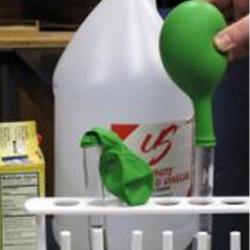Source Institutions
Source Institutions
Add to list Go to activity
Activity link broken? See if it's at the internet archive

This activity was designed for blind learners, but all types of learners can participate to learn about conservation of gas. This is one of the classic experiments using baking soda and vinegar. The expansion of a balloon with gas provides a tactile experience as the gas is captured rather than being released into the air. The evidence of conservation of mass is supported by the collection of data, by weighing the masses of the reactants before and after the experiment. Learners with visual impairments and sighted students can also learn that matter is neither created nor destroyed during a chemical change.
- 5 to 10 minutes
- 10 to 30 minutes
- $1 - $5 per student
- Ages 8 - 14
- Activity, Experiment/Lab Activity
- English
Quick Guide
Materials List (per student)
- Tray
- Baking soda
- Vinegar
- Balloon
- Funnel
- Approximately 20 oz. plastic bottle with small neck
- Talking scale or pan balance
- Measuring cups
Subjects
-
Life Sciences
-
Cells
- Cell Division
-
Cells
-
Physical Sciences
-
Chemistry
- Chemical Reactions
- Acids and Bases
-
States of Matter
- Solids
- Liquids
- Gases
- Changes of Phase
-
Chemistry
Audience
To use this activity, learners need to:
- touch
Learning styles supported:
- Involves teamwork and communication skills
- Involves hands-on or lab activities
Other
Components that are part of this resource:
Access Rights:
- Free access
By:
Rights:
- All rights reserved, Perkins School for the Blind,
